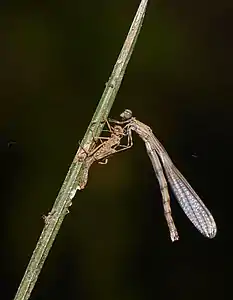Prodasineura verticalis
Prodasineura verticalis[2][1] is a damselfly in the family Platycnemididae. It is commonly known as the red-striped black bambootail[3] or black bambootail.[4]
| Prodasineura verticalis | |
|---|---|
 | |
| male | |
_female_(31026882414).jpg.webp) | |
| female | |
| Scientific classification | |
| Kingdom: | |
| Phylum: | |
| Class: | |
| Order: | |
| Family: | |
| Genus: | |
| Species: | P. verticalis |
| Binomial name | |
| Prodasineura verticalis (Selys, 1860) | |
| Synonyms | |
| |
Distribution
Prodasineura verticalis can be found in these Asian countries, which are China, Guangxi, India, Indonesia, Laos, Malaysia, Peninsular Malaysia Myanmar, Singapore, and Thailand.[1][5]
Subspecies
This damselfly species has six subspecies. The following are the subspecies.[1]
- Prodasineura verticalis andamanensis (Andaman and Nicobar Islands)
- Prodasineura verticalis annandalei (South India)
- Prodasineura verticalis burmanensis
- Prodasineura verticalis delia
- Prodasineura verticalis humeralis (often treated as a distinct species)
- Prodasineura verticalis verticalis
Description and habitat

It is medium size damselfly with black-capped brown eyes. Its hindwings are about 19–20 mm and the abdomen about 30 mm. The male of this damselfly is mostly black with red and yellow stripes on its thorax and small yellow spots on the abdomen. The pterostigma or the wing spot is diamond-shaped and is dark brown in colour. Abdomen is black with segments 3 to 6 have small base-dorsal yellow spots. Remaining segments are unmarked. The female is similarly marked to the male; but the thoracic stripes are paler and more yellowish.[6]
They are commonly found along the banks of large ponds and rivers, usually sitting among emergent water plants. The oviposition takes place on vegetation or on submerged roots in shallow running water, with the pair in tandem.[6][7][8][4][3]
See also
References
- Dow, R.A. (2010). "Prodasineura verticalis". IUCN Red List of Threatened Species. 2010: e.T167096A6301209. doi:10.2305/IUCN.UK.2010-4.RLTS.T167096A6301209.en. Retrieved 19 November 2021.
- Paulson, D.; Schorr, M.; Abbott, J.; Bota-Sierra, C.; Deliry, C.; Dijkstra, K.-D.; Lozano, F. (2023). "World Odonata List". OdonataCentral, University of Alabama. Retrieved 14 Mar 2023.
- "Prodasineura verticalis Selys, 1860". Odonata of India, v. 1.00. Indian Foundation for Butterflies. Retrieved 2017-03-12.
- "Prodasineura verticalis Selys, 1860". India Biodiversity Portal. Retrieved 2017-03-12.
- K.A., Subramanian; K.G., Emiliyamma; R., Babu; C., Radhakrishnan; S.S., Talmale (2018). Atlas of Odonata (Insecta) of the Western Ghats, India. Zoological Survey of India. pp. 124–125. ISBN 9788181714954.
- C FC Lt. Fraser (1933). The Fauna of British India, including Ceylon and Burma, Odonata Vol. I. Red Lion Court, Fleet Street, London: Taylor and Francis. pp. 213-218.
- C FC Lt. Fraser (1924). A Survey of the Odonate (Dragonfly) Fauna of Western India with Special Remarks on the Genera Macromia and Idionyx and Descriptions of Thirty New Species (PDF). Zoological Survey of India. Volumes (Records). pp. 503–504.
- Subramanian, K. A. (2005). Dragonflies and Damselflies of Peninsular India - A Field Guide.
External links
![]() Data related to Prodasineura verticalis at Wikispecies
Data related to Prodasineura verticalis at Wikispecies
![]() Media related to Prodasineura verticalis at Wikimedia Commons
Media related to Prodasineura verticalis at Wikimedia Commons

